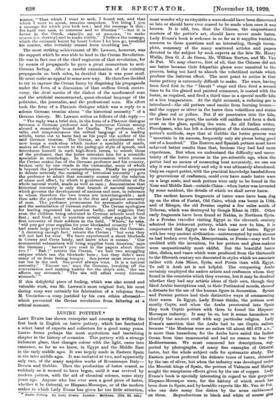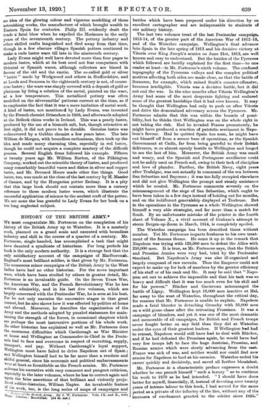LUSTRE POTTERY.*
LADY Evers has shown enterprise and courage in writing the first book in English on lustre pottery, which has fascinated a select band of experts and collectors for a good many years. Lustre forms perhaps the most mysterious and tantalizing chapter in the history of ceramics. This pottery with a strange iridescent glaze, that changes colour with the light, came into existence, so far as we know, in Egypt and the Middle East in the early middle ages. It was largely made in Eastern Spain in the later middle ages. It was imitated at two, and apparently only two, of the many majolica works of Renaissance Italy- Deruta and Gubbio. Then the production of lustre ceased, as suddenly as it seemed to have begun, until it was revived by modem potters, with the aid of chemical science, some sixty years ago. Anyone who has ever seen a good piece of lustre, whether it be Oriental, or Hispano-Moresque, or of the modern makes to which Lady Evans has given far too little attention, " integre Pottery. By Lady Evans. London Methuen. 152s. 6d. nee] must wonder why so exquisite a ware should have been discovered so late or should have ever ceased to be made when once it was known. It is odd, too, that the Chinese, the unquestioned masters of the potter's art, should have never made lustre. Lady Evans's book is weloome in so far as it supplies tentative answers to these questions and an interesting, though incom- plete, summary of the many scattered articles and papers devoted to the subject by such experts as the late Mr. Henry Wallis, Don G. J. de Osma, Mr. William Burton, and Mr. Van de Put. We may observe, first of all, that the Chinese did not use lustre because their felspathic glazes were unsuited to the process, being too hard to absorb the volatilized metals which produce the lustrous effect. The next point to notice is that lustre pottery is extremely difficult to make. The ware, having been fired first in the " biscuit " stage and then fired a second time to fix the glazed and painted ornament, is coated with the lustre, as required, and fired a third time in a special muffle-kiln at a low temperature. At the right moment, a reducing gas is introduced—the old potters used smoke from burning broom— and the copper or silver in the lustre then volatilizes and stains the glaze red or yellow. But if air penetrates into the kiln, or the heat is too great, the metals will oxidize and form a dark crust on the glaze, spoiling the ware. An old Italian writer, Piecolpasso, who has left a description of the sixteenth-century potter's methods, says that at Gubbio the lustre process was " uncertain in its success, frequently only six pieces being good out of a hundred." The Eastern and Spanish potters must have achieved better results than that, because they had had more experience. But when we understand the difficulty and uncer- tainty of the lustre process in the pro-scientific age, when the potter had no means of measuring heat accurately, we can see why it was evolved slowly and why it was ultimately abandoned. Only an expert potter, with the practical knowledge handeddown by generations of craftsmen, could ever have made lustre ware on a large scale, and such potters were only to be found in the Near and Middle East—outside China—when lustre was invented by some accident, the details of which we shall never know.
The earliest known fragments of lustre ware have been dug up on the sites of Fostat, Old Cairo, which was burnt in 1168, and of Rhages, the old Persian capital a few miles south of Teheran, which was destroyed by Gengis Khan in 1221. Other early fragments have been found at Rakes, in Northern Syria. As a Persian traveller visiting Egypt in the eleventh century admired the iridescent pottery, which was new to him, it is conjectured that Egypt was the true home of lustre. Egypt with her very ancient civilization—uninterrupted by such germs as had broken over Syria, Mesopotamia, or Persia—may well be credited with the invention, for her potters and glass-makers were unquestionably most skilful. But the beautiful lustre tiles, dishes, and vases which were produced from the thirteenth to the fifteenth century are decorated in styles which we associate rather with Asia Minor, Syria, and Persia than with Egypt. To call it Arab art is not helpfuL The conquering Arabs certainly employed the native artists and craftsmen whom they found in the countries which they overran, but it may be doubted whether they had any artistic ideas of their own, though they liked Arabic inscriptions and, in their Puritanical moods, showed a distaste for the use of the human figure in decoration. Syrinx] and Persian potters had their distinctive ways of ornamenting their wares. In Egypt, Lady Evans thinks, the potters were mostly Copts, and when the Arabs penetrated into Spain they took Coptic potters with them to found the Ilispeno- Moresque industry. It may be so, but it seems hazardous to identify the ancient craft with any particular religion. Lady Evans's assertion that the Arabs had to use Coptic sailors, because "the Moslems were no sailors till about 661-679 AM.," is more than hazardous, for the Arabs have sailed the Indian Ocean from time immemorial and had no reason to fear the Mediterranean. We must commend her descriptions, sup- ported by photographs, of many fine examples of Oriental lustre, but the whole subject calls for systematic study. The Eastern potters preferred the delicate tones of lustre, obtained by the use of silver, but when the industry was developed under the Moorish kings of Spain, the potters of Valencia and Malaga sought the sumptuous effects given by the use of copper. Lady Evans's book is specially interesting in regard to this gorgeous Hispano-Moreaque ware, for the history of which much has been done in Spain, and by heraldic experts like Mr. Van de Put, who can date many fine dishes by the arms emblazoned on them. Reproductions in black and white of course give no idea of the glowing colour and vigorous modelling of these astonishing works, the manufacture of which brought wealth to Eastern Spain for centuries. Philip III. evidently dealt the trade a fatal blow when he expelled the Morisooes in the early years of the seventeenth century. The pottery industry and other skilled mita languished and died away from that time, though in a few obscure villages Spanish potters continued to make a rude lustre ware till late in the nineteenth century. Lady Evans might well have devoted more than four pages to modern lustre, which at its best need not fear comparison with Oriental or Spanish wares, although collectors are biased in favour of the old and the exotic. The so-called gold or silver " lustre " made by Wedgwood and others in Staffordshire, and at Leeds and Swansea in the eighteenth century is not, of course true lustre ; the ware was simply covered with a deposit of gold or platinum by firing a solution of the metal, painted on the ware, at a low temperature. This metallized pottery was often modelled on the silversmiths' patterns current at the time, as if to emphasize the fact that it was a mere imitation of metal-work. A kind of lustre, not mentioned by Lady Evans, was invented by the French chemist Brianahon in 1856, and afterwards adopted at the Belleek china works in Ireland. This was a pearly lustre, produced by the use of a bismuth salt, but, though attractive at first sight, it did not prove to be durable. Genuine lustre was rediscovered by a Gubbio chemist a few years later. The late William de Morgan, with boundless enthusiasm, then took up the idea and made many charming tiles, especially in red lustre, though he could not acquire a complete mastery of the difficult process. Several English firms followed his example. Fifteen or twenty years ago Mr. William Burton, of the Pilkington Company, worked out the scientific theory of lustre, and produced many remarkably beautiful vases and dishes in silver and copper lustre, and Mr. Bernard Moore made other fine things. Good lustre, too, was made at the close of the Mat century by M. Messier of Cannes, and by the Hungarian potter Zsolnay. It is a pity that this large book should not contain more than a cursory reference to these modern lustre wares, which illustrate the successful application of science to the ancient craft of the potter. We are none the leas grateful to Lady Evans for her book on a too long neglected subject.







































 Previous page
Previous page